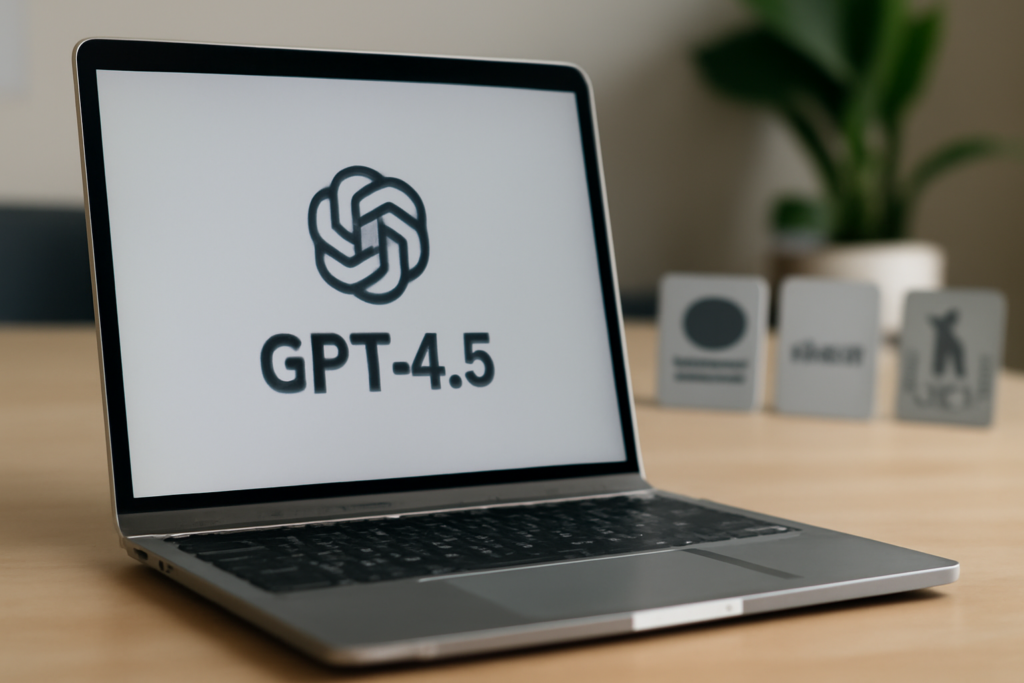Physical Address
304 North Cardinal St.
Dorchester Center, MA 02124
Physical Address
304 North Cardinal St.
Dorchester Center, MA 02124

Have you ever wondered how AI chat online models of language, like ChatGPT and Gemini, are revolutionizing industries? With the rise of advanced AI, language models have become indispensable tools for content creation and real-time translation. One of the most notable breakthroughs in this revolution is GPT-4.5, which has elevated the potential of AI in understanding and generating language. This model is more accurate, fluid, and capable of tackling complex tasks that once required human expertise.
But as AI becomes more advanced, it leads us to a crucial question: Could this be the end of technical writer vacancies? With the capabilities of AI like GPT-4.5, many industries are increasingly turning to AI to handle content generation, documentation, and even translation. This has left many wondering if the demand for traditional technical writers will decrease. AI-powered systems are now capable of writing detailed instructions, creating manuals, and translating complex texts—tasks that were once the sole domain of human technical writers.
As we explore this shift, we’ll look at the impact of AI on technical writer vacancies and what it means for the future of these professions. Could AI really replace the need for human technical writers, or is there still room for both in an evolving landscape?
GPT-4.5 is an upgraded version of GPT-4, bringing faster speed, better accuracy, and enhanced multilingual support. It understands and generates language more smoothly, making AI chat online models of language even more reliable. Compared to other language models like Gemini, Claude, and Llama, GPT-4.5 stands out due to its improved handling of complex tasks and deeper understanding of context.
When it comes to translation, GPT-4.5 plays a significant role. It is being integrated into the best translation software, offering more precise translations than traditional tools. For example, while Google Translate has been popular for years, AI-powered tools like GPT-4.5 and Deeply provide more natural-sounding translations. This advancement is changing the way companies approach translation and documentation.
As AI models continue to improve, questions arise about technical writer vacancies. With AI’s ability to generate accurate content and translations, will human writers still be needed? Only time will tell.

AI chat online tools have become game changers in content creation. These AI models, like GPT-4.5, automate the process of generating documentation, tutorials, and FAQs. By simply providing AI with the right prompts, it can produce clear, accurate, and well-structured content in no time. This efficiency is especially beneficial for companies that need to frequently update or create technical content, as AI can handle repetitive tasks such as writing manuals, generating product descriptions, and creating troubleshooting guides.
Several companies have already started using AI to reduce technical writer vacancies. For example, large software firms are integrating GPT-4.5 and similar AI models into their content creation processes. These tools can write code documentation, user guides, and even customer support materials with minimal human input. As a result, businesses save both time and money while maintaining the quality of their content.
There are several benefits to using AI-generated technical content. AI tools are fast and can work around the clock without breaks, allowing companies to produce large amounts of content in less time. Additionally, AI models like GPT-4.5 offer high accuracy, and with their multilingual support, they can also provide content in multiple languages, making them ideal for global businesses. The best translation software also benefits from these advancements, helping companies deliver consistent translations quickly.
While AI can replicate the structure and tone of human content, it sometimes lacks the nuance and deep understanding that a human writer brings to the table. For example, complex technical concepts that require expert knowledge may be better explained by a human technical writer, who can add insights, context, and ensure clarity in a way AI might miss.
The rise of AI in content creation is undeniable, but it raises questions about the future of technical writer vacancies. While AI can handle many aspects of documentation and translation, the need for human expertise remains crucial for ensuring content quality and addressing complex topics. AI and humans can work together to improve efficiency, but the role of skilled technical writers is still valuable in areas that require human intuition and expertise.

The world of translation has changed significantly over the years, and in 2024, AI-powered tools are making a big impact. Top translation software such as DeepL, GPT-4.5, and Trados have revolutionized how we approach translation tasks. These tools, especially AI-driven ones like GPT-4.5, provide fast, accurate translations that can handle multiple languages, making them a go-to option for businesses and individuals alike. But how do these AI systems compare to traditional human translation services, and can they really replace professional translators?
While AI-powered tools like GPT-4.5 and DeepL are impressive, they cannot fully replace professional translators just yet. These AI systems are highly effective for basic translations or translating familiar phrases, but they may struggle with context, tone, and cultural nuances that human translators excel at. For example, GPT-4.5 might translate a technical manual quickly, but it lacks the deep understanding a professional translator brings to specialized subjects. In many cases, human translators are needed to ensure the message is culturally appropriate and contextually accurate.
With AI tools like GPT-4.5 becoming more efficient at language translation, there’s growing concern about their impact on multilingual technical writer vacancies. While AI can automate many tasks, human technical writers who specialize in languages and technical documentation are still valuable. These writers add expertise, creativity, and local knowledge that AI cannot match. So, while AI may reduce some demand for traditional translation roles, there will always be a need for skilled human translators and technical writers to provide expertise and oversight
While AI translation software like GPT-4.5 offers powerful tools for quick and accurate translations, human translators still have an essential role to play, especially in technical writing and complex language tasks. AI is changing the landscape, but it won’t fully replace the human touch anytime soon.
As artificial intelligence continues to advance, many are questioning whether models like GPT-4.5 will replace traditional technical writer jobs. While AI brings many benefits, it also presents both challenges and opportunities for the profession.
Less Need for Traditional Writers:
With AI handling the bulk of the content creation, there may be fewer openings for traditional technical writing positions. This shift could impact job opportunities for writers, especially in industries where AI tools are already integrated into the workflow.
Automation of Documentation:
AI tools can now generate technical content quickly, reducing the need for human writers. As AI becomes more efficient at creating documents, manuals, and FAQs, businesses may rely on these systems more than traditional writers.
Faster Content Production:
AI systems can generate content at a much faster rate than humans. This means companies can produce large volumes of content in less time, potentially minimizing the demand for human writers who traditionally took longer to complete these tasks.
Cost-Effective Solution:
Since AI can work without breaks and is faster than humans, it becomes a more cost-effective option for businesses. This cost-cutting benefit could reduce the number of job openings for traditional technical writers as businesses look to optimize their resources.
In conclusion, while automation brings challenges, it also creates new opportunities for writers. These changes shift their focus from routine tasks to more creative and specialized roles. Writers can embrace these evolving responsibilities, leveraging AI tools to enhance their work, allowing them to contribute in areas requiring creativity, expertise, and human insight.
AI language models like GPT-4.5 are changing the way we write, but they won’t fully replace human writers. While AI is great at generating content quickly, it lacks the creativity, emotional insight, and deep understanding that humans bring to the table. For complex topics, storytelling, or content that requires a personal touch, AI just can’t match the nuance that a skilled human writer offers. It can assist with routine tasks, but the heart of writing remains human.
To stay relevant in the age of AI, writers need to embrace collaboration with these tools. Instead of seeing AI as a threat, writers can view it as a partner that can help make their work easier and more efficient. Upskilling is key to adapting. Writers can start by learning about prompt engineering, which is the art of guiding AI with clear instructions to get the best output. Familiarizing themselves with different AI tools will also make them more efficient and effective in their roles.
By developing these new skills, technical writers can continue to offer value in areas where AI struggles, like tackling complex subjects that require human judgment and creativity. The future of writing will be about working together with AI, using its strengths to improve the writing process while still relying on human expertise for the more nuanced and creative aspects. Writers who embrace this change will find plenty of opportunities in the evolving landscape of content creation.

As we’ve explored, AI tools, like GPT-4.5 and other advanced language models, are reshaping the content creation landscape. They offer efficiency, speed, and accuracy, making tasks like documentation, translation, and technical writing faster and more cost-effective. However, while these tools are powerful, they cannot fully replace the creativity, nuance, and expertise that human technical writers bring. AI is a tool that works best alongside human input, allowing writers to focus on higher-level tasks while the AI handles routine content generation.
There are also new opportunities emerging for writers, such as roles in AI training, editing, and refining AI-generated content. Writers who adapt to using these tools will find themselves in demand, as the need for skilled professionals to guide AI systems remains strong.
The future of technical writing is not about AI replacing human workers but about how writers can collaborate with AI to improve productivity. Writers who use AI will be able to accomplish more and remain relevant in an increasingly automated world. As the saying goes, “AI won’t replace technical writers—but writers using AI will replace those who don’t.”
For more insights on how AI can enhance your content, visit our website at icebergaicontent.com. Embracing AI tools is the key to staying ahead in the evolving world of technical writing.
1. How will AI impact technical writer vacancies?
AI tools like GPT-4.5 will automate routine tasks, but human writers are still needed for creative, nuanced work. Writers using AI will stay relevant, while those who don’t adapt may face fewer opportunities.
2. What are the benefits of AI for technical writing?
AI helps technical writers create content faster, with improved accuracy and cost-efficiency. It also supports multilingual translation, making it ideal for global content creation.
3. Can AI replace human translators?
AI tools like GPT-4.5 can handle basic translations, but human translators are still necessary for complex, nuanced tasks, especially in technical writing.
4. How can technical writers upskill to stay relevant?
Writers should learn to use AI tools and improve their skills in prompt engineering and content editing. This will help them collaborate with AI for better productivity.
5. What’s the role of AI in translation software?
AI-powered translation software, like GPT-4.5 and DeepL, offers fast and accurate translations. However, human translators still play a key role in ensuring quality and contextual accuracy.
6. How does GPT-4.5 compare to other translation tools?
GPT-4.5 stands out for its speed, accuracy, and multilingual support, making it a strong choice for translation tasks, though DeepL and Google Translate are still popular for everyday use.
7. Will AI replace all types of writing jobs?
AI will transform many writing jobs, but it cannot replace all aspects of writing, especially tasks that require human creativity and deep expertise, like technical writing and content strategy.